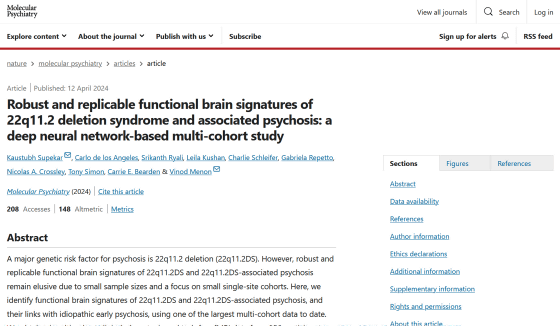AI research reveals brain networks that cause hallucinations and delusions in patients with schizophrenia

Robust and replicable functional brain signatures of 22q11.2 deletion syndrome and associated psychosis: a deep neural network-based multi-cohort study | Molecular Psychiatry
https://www.nature.com/articles/s41380-024-02495-8

Two key brain systems are central to psychosis, Stanford Medicine-led study finds | News Center | Stanford Medicine
https://med.stanford.edu/news/all-news/2024/04/brain-systems-psychosis.html
AI pinpoints where psychosis originates in the brain | Live Science
https://www.livescience.com/health/mind/ai-pinpoints-where-psychosis-originates-in-the-brain
Patients who experience psychosis experience hallucinations, in which they see or hear things or people that do not exist, and delusions in which they believe things that are not real are true. These symptoms have a significant negative impact on patients with schizophrenia and other conditions, so it is important to understand what mechanisms are causing these symptoms.
However, it is difficult to study what causes psychosis using brain scans, etc. One reason is that these patients are often taking antipsychotics for long periods of time, making it difficult to distinguish between changes in the brain related to the symptoms and changes in the brain caused by the drugs.

Therefore, a research team from Stanford University and others conducted brain scans
The research team collected brain scan data from 101 patients with 22q11.2 deletion syndrome, as well as about 900 people in total, including people with psychosis, autism, and ADHD who do not have 22q11.2 deletion syndrome, and healthy controls. By collecting brain scan data from people with ADHD and autism for comparison, it became possible to analyze patterns specific to psychosis.

The team, working with computer scientists at Stanford University, developed an AI algorithm to find patterns in fMRI brain scan data, which they say identifies common brain activity patterns in psychosis patients with 22q11.2 deletion syndrome and in those with independent psychosis.
Analysis by the AI algorithm revealed that the brains of patients with psychosis showed characteristic patterns in a network called the ' salience network ,' which is responsible for processing external stimuli. Two nodes in the salience network, the anterior insular cortex , which filters out unimportant information, and the ventral striatum , which predicts the rewards that information brings, were associated with psychosis.
The results of this study not only deepen our understanding of the mechanisms by which psychosis occurs, but may also be useful in preventing psychosis and schizophrenia. 'One of my goals is to prevent or delay the onset of schizophrenia,' said Kaustov Spekal , an associate professor of psychiatry and behavioral sciences at Stanford University and lead author of the paper.
Related Posts:
in Science, Posted by log1h_ik







